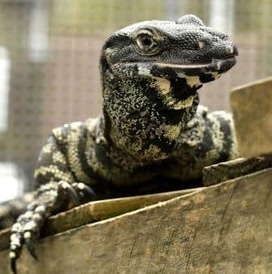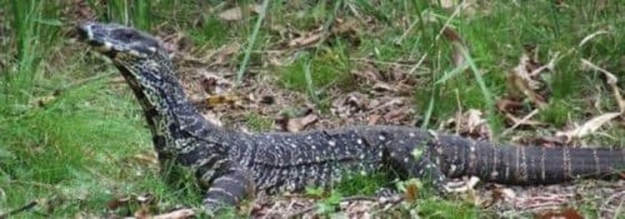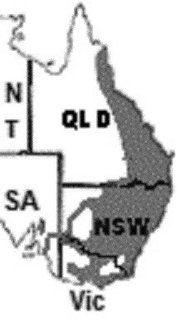Lace MonitorVaranus varius |

Custom Search
|
They inhabit forests, woodlands, slopes and coastal tableland habitats. The lace monitor is regarded as the 2nd largest monitor found in Australia after the perentie (Varanus giganteus).
They can reach over 6.8 ft (2.1 m) in total length, with a long and slender tail that measures about 1.5 times the length of the head and body. Their maximum weight can be up to 20 kg (44 lb), but most adult specimens are much smaller. The lace monitor has 2 distinct forms, with patterns and coloration dependent on their habitat. The more usual form is a dark gray or dark blue back with many scattered cream, yellow or white spots, and narrow black and cream bands on the tail which get wider towards the end. The other form typically found in drier regions of Queensland and New South Wales and is called "Bell’s" phase or form. Typically these specimens have broad, black and yellow cross-bands all over the body and tail. Up close we can see that these "bands" are actually made up of numerous spotted patterns. The lace monitor snout and jaws are usually marked with prominent yellow and dark gray to black bands. The belly is cream. Being an arboreal species their toes have long, strong claws used for climbing trees. Much like that of snakes, they have a long forked tongue.
They have very strong jaws equipped with very long and sharp teeth which will inflict severe injuries.
Some recent studies at the University of Melbourne demonstrate that monitor lizards do in fact produce a mild venom similar to that of venomous snakes. These toxins have only minimal effects on humans, but it may help these lizards subdue small animals. They are active from September to May, spending much of their time up large trees. But in cooler weather, they become inactive and will take shelter in tree hollows or under fallen trees or large rocks. Lace monitors are preyed upon by birds of prey and dingoes, but if feeling threatened they run for the nearest tree climbing it to safety. Their average lifespan in the wild is about 10 to 15 years however some captive lace monitors have been known to live up to 40 years. Like other lizards, such as the Perentie (Varanus giganteus) the Australian Aboriginal peoples ate them and use their fat as medicine and in ceremonies. 
Subspecies / Etymology / Taxonomy
There are no subspecies recognized for Lace monitors. The species was first described as Lacerta varius by George Shaw in 1790. While the word Varanus is a Latinisation of Waran an Arabic word, meaning lizard, "goanna" usually used to refer lizards in Australia is a corruption of "iguana". Lace Monitor Diet Lace monitors have a varied diet that includes small mammals, birds and their eggs, other reptiles and even insects. They travel over long distances of up to 3 km a day to forage. They regularly attack large nests of scrub turkeys to get to the eggs and often display injuries on their tails inflicted by the males pecking at them to force these goannas away. They are predators but also scavengers readily eating carrion including road kill, often times several individuals feed on the same carcass. They will also forage in areas inhabited by people, attacking chicken coops for eggs and poultry, also scavenge around bins in camping and picnic areas and domestic garbage bags. These monitors like most reptiles are able to remain several weeks without feeding after a large meal. Lace Monitor Reproduction The Lace Monitor is a solitary animal except during the mating season, that occurs from September to December during spring and early summer. The lace monitor reaches sexual maturity at about 4 to 5 years of age. Several males will engage in ritualistic combats to establish dominance and mate with a receptive female. The rivals will stand up on their hind legs holding each other up with the front legs trying to intimidate one another by inflating their throat pouch. Ultimately one male is going to fall to the ground, or retreat in defeat. Most females breed every year laying anywhere from 4 to 14 eggs, 4 to 6 weeks after mating with the male. To incubate their eggs they have a unique approach, females dig a hole on the side of a termite mound and lays her eggs inside. The termites will then repair the mound sealing the eggs inside it. There the eggs lie undisturbed and with a stable temperature of about 30ºC, for a period of 8 or 9 months when they are ready to hatch. The female then returns to the nest and digs it up with her strong claws to allow the hatchlings to escape. Sometimes females will nest in a hole in the ground if they can't find a termite nest to lay their eggs. Then they fill the hole with leaf litter and the heat from the decomposing vegetation helps to keep the eggs warm. Lace Monitor Conservation status and main threats The lace monitor is not considered vulnerable and isn't classified as a threatened species. But the species has not yet been assessed for the IUCN Red List.
|
Scientific classification
Kingdom: Animalia Phylum: Chordata Class: Reptilia Order: Squamata Family: Varanidae Genus: Varanus Subgenus: Varanus Species: V. varius |


